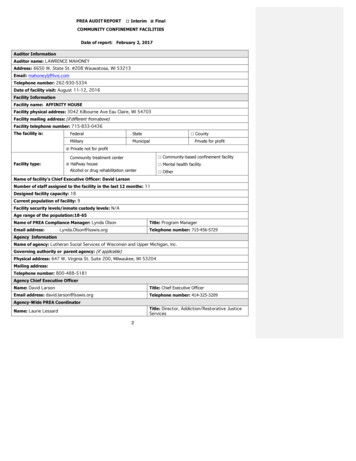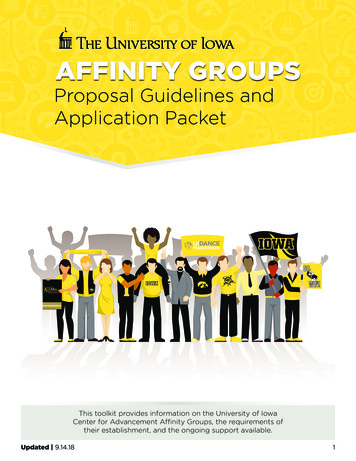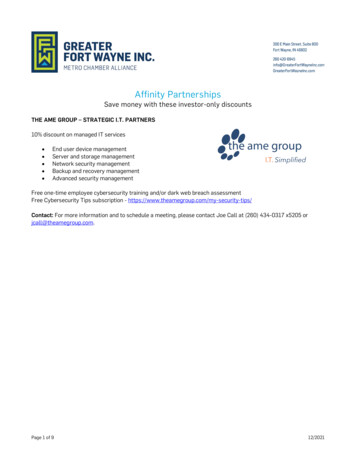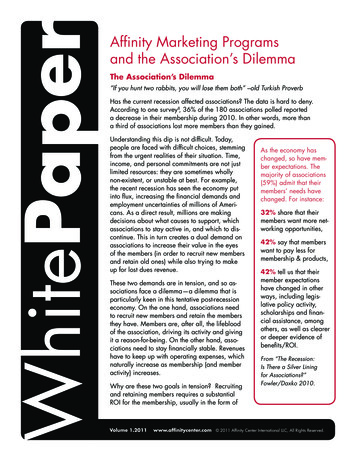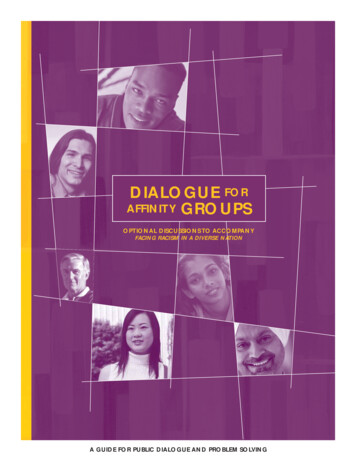
Transcription
DIALOGUE FORAFFINITY GROUPSOPTIONAL DISCUSSIONS TO ACCOMPANYFACING RACISM IN A DIVERSE NATIONA GUIDE FOR PUBLIC DIALOGUE AND PROBLEM SOLVING
Everyday Democracy (formerly the Study Circles Resource Center) is a national organizationthat helps local communities find ways for all kinds of people to think, talk and work together tosolve problems. We work with neighborhoods, cities and towns, regions, and states, helping them payparticular attention to how racism and ethnic differences affect the problems they address.Everyday Democracy has been helping people do this work throughout the nation since 1989. Our organization hasgrown — we now have 13 full-time staff members, plus associates across the country and a network of hundredsof communities. We provide advice and training, and then use what we learn to benefit other communities. Thiswork has yielded innovative, effective tools and processes with a proven track record of furthering the efforts ofpeople who are looking for ways to organize dialogue that leads to change where they live.We want to help you work for long-term change in your community. Please see our website atwww.everyday-democracy.org for information about how to create large-scale dialogue-to-actionprograms that engage hundreds (and sometimes thousands) of residents. Call us for help at 860-9282616, or e-mail us at info@everyday-democracy.org.This affinity group guide is available on our website in English and Spanish. It is intended to be usedwith Facing Racism in a Diverse Nation, which is available in English and Spanish on our websiteand in print from Everyday Democracy.Writers: Carolyne Miller Abdullah and Susan McCormackContributing Editor: Molly Holme BarrettResearch Assistance: Nick ConnellEditorial Assistance: Phil RoseTranslators: Alvino E. Fantini and Beatriz C. FantiniLayout and Design: OmniStudioProduction: Carrie Boron and Francine NicholsSpecial thanks go to the concept team for its assistance during all phases of the development of this guide:Jon Abercrombie, Common Focus, Decatur, Georgia; Senior Associate, Everyday DemocracySarah vL. Campbell, Senior Program Director, Everyday DemocracyFran Frazier, Senior Associate, Everyday DemocracyJohn Landesman, Director, Montgomery County, Maryland, Public Schools Study Circles Program;Senior Associate, Everyday DemocracyWilliam T. Lewis, Sr., Director of Diversity, Indiana University Kelley School of Business; Senior Associate,Everyday DemocracyAmy Malick, Communication Director, Everyday DemocracyMartha L. McCoy, Executive Director, Everyday DemocracyGloria Mengual, Program Director, Everyday DemocracyPatrick L. Scully, Deputy Director, Everyday DemocracyBarbara Yasui, Instructor, Everett Community College, Everett, Washington; Senior Associate,Everyday Democracy 2008 by The Paul J. Aicher FoundationPermissions Policy: Photocopying this guide for the purpose of organizing dialogue-to-change programs is permitted. Reproducing any portions of thisguide for other purposes requires our written permission.2www.everyday-democracy.orgEVERYDAY DEMOCRACYDialogue for Affinity Groups
CONTENTSINTRODUCTION . . . . . . . . . . . . . . . . . . . . . . . . . . . . . . . . . . . . . . . . . . . . . . . . . . . . . . . . . . . . . . . . . . . . . . .4OVERVIEW . . . . . . . . . . . . . . . . . . . . . . . . . . . . . . . . . . . . . . . . . . . . . . . . . . . . . . . . . . . . . . . . . . . . . . . . . . . . .5SESSION 1—Making Personal and Group Connections to the Issue . . . . .6Key Areas of Concern for:4A: African Americans . . . . . . . . . . . . . . . . . . . . . . . . . . . . . . . . . . . . . . . . . . . . . . . . . . . . . . . . . . . . . . . . . . . .84B: Asian Americans . . . . . . . . . . . . . . . . . . . . . . . . . . . . . . . . . . . . . . . . . . . . . . . . . . . . . . . . . . . . . . . . . . . . .94C: Hispanics . . . . . . . . . . . . . . . . . . . . . . . . . . . . . . . . . . . . . . . . . . . . . . . . . . . . . . . . . . . . . . . . . . . . . . . . . 104D: Native Americans. . . . . . . . . . . . . . . . . . . . . . . . . . . . . . . . . . . . . . . . . . . . . . . . . . . . . . . . . . . . . . . . . . . 114E: Recent Immigrants . . . . . . . . . . . . . . . . . . . . . . . . . . . . . . . . . . . . . . . . . . . . . . . . . . . . . . . . . . . . . . . . . 124F: Whites . . . . . . . . . . . . . . . . . . . . . . . . . . . . . . . . . . . . . . . . . . . . . . . . . . . . . . . . . . . . . . . . . . . . . . . . . . . 134G: People of Color (mixed)* . . . . . . . . . . . . . . . . . . . . . . . . . . . . . . . . . . . . . . . . . . . . . . . . . . . . . . . . . . . . 144H: Blank Form. . . . . . . . . . . . . . . . . . . . . . . . . . . . . . . . . . . . . . . . . . . . . . . . . . . . . . . . . . . . . . . . . . . . . . . . 15SESSION 2—Preparing Ourselves for Mixed-Group Dialogue . . . . . . . . . . . 17SESSION 3—Addressing Community Change . . . . . . . . . . . . . . . . . . . . . . . . . . . . . . . . 19* Designed for communities where the number of people of color may be small and/or for people identifying as having multi-racial backgrounds.Dialogue for Affinity GroupsEVERYDAY DEMOCRACYwww.everyday-democracy.org3
INTRODUCTIONThe goal of the affinity sessions is to give peoplewith similar racial or ethnic backgrounds anopportunity to talk about issues that are veryimportant to them. Individuals who considerthemselves multiracial may choose any affinitygroup where they feel they belong. These are notintended to be used as stand-alone sessions. Theyare designed to add to a community-wide dialogueon racism.1) Why hold affinity group dialogues? Through talking with people who are likeus, we can gain new insights into our ownbeliefs as well as others. We can gain support. We can practicetalking about difficult issues before we joindiscussions in a mixed group. We can unpack our own “baggage” beforejoining dialogues with mixed groups.4www.everyday-democracy.org2) How can affinity group dialogues helpus make progress on racism? Participants gain mutual support and learnthat they have a voice in making a difference. Participants build new relationships and trust. Participants explore different ways to workwith others.The affinity sessions are optional. Two sessionstake place before the community-wide dialoguesbegin. The third session happens after thecommunity-wide dialogue ends.Session 1 helps us connect with the issue ofracism and each other. In Session 2, we talk abouthow people from different backgrounds can bringabout change in the community. In Session 3, wereconnect, and identify what action we can take.EVERYDAY DEMOCRACYDialogue for Affinity Groups
Overview of How Affinity Groups Fit into aDialogue-to-Change ProgramOrganizeAffinity Group Session 1 Involve diverse groups of peoplefrom all walks of lifeMaking Personal and GroupConnections to the Issue Engage community leaders Plan for dialogue and the actionthat will followAffinity Group Session 2Preparing Ourselves forMixed-Group DialogueHold Dialogue Build new relationships and trust Raise awareness and considera range of viewsFacing Racism in aDiverse Nation(Six Sessions) Develop new ideas Create action ideasAffinity Group Session 3Addressing Community ChangeAct Carry out action ideas Assess the change that is happening Tell the storyDialogue for Affinity GroupsEVERYDAY DEMOCRACYwww.everyday-democracy.org5
Session 1MAKING CONNECTIONSSession 2MIXED-GROUP DIALOGUESession 3ADDRESSING COMMUNITY CHANGESESSION 1Making Personal and Group Connections to the IssueFacilitator Notefor Part 1Introduce yourselfas the facilitator.Explain that your jobis to help the groupmembers have a richconversation andmake room for allvoices. Make it clearthat you will notshare personal viewsand stories, or try topush an agenda.In this session, we will talk about how racism affects our lives. We will also learn more about how we areconnected to one another. And we will discuss how racism affects us as a group.PART 1: Introductions/WhoWe Are (10 minutes)PART 2: Overview of the Process(10 minutes)Say your name and why you decided to take part inthis affinity group.Before we begin our conversation, we will spenda few minutes talking about what will happenduring the dialogue. (Take a look at the overviewon page 5.)To help the dialogue work well, we need to agreeabout how we are going to talk together. We canuse the following list as a starting point to developour own guidelines.Facilitator Notefor Part 2 Be respectful.Refer to page 5 foran overview of theprocess. Everyone gets a fair hearing. Share “air time.” One person speaks at a time. Speak foryourself, not for others.Talk about thepurpose of the affinitysessions, and explainthat they are part ofthe community-widedialogue. If you are offended, or uncomfortable say so; andsay why. You can disagree, but don’t personalize it. Stickto the issue. No name-calling or stereotyping. Everyone helps the facilitator keep thediscussion moving and on track.Explain the purposeof the discussionguidelines. Then, askgroup members todevelop their own listof guidelines. Recordthem on newsprintand post themwhere everyonecan see them. Fora start, refer tothe list of sampleguidelines. Personal stories remain confidential unless thegroup decides it’s OK to tell them to other people.6www.everyday-democracy.orgEVERYDAY DEMOCRACYDialogue for Affinity Groups
Session 1MAKING CONNECTIONSSession 2MIXED-GROUP DIALOGUESession 3ADDRESSING COMMUNITY CHANGEPART 3: Exploring Identity(40 minutes)Facilitator Notefor Part 31. Describe your racial or ethnic background.Some peoplemay want to talkabout the meaningof “racism” and“discrimination.” Letthem talk about itthe way they see it.There is no need forthe group to agreeabout definitions, butyou can point outcommon themes.2. When was the first time you realized you belongto a certain racial / ethnic group? What did thatmean to you?3. When was the first time you noticed peoplewho were different from you? What do youremember?4. When you think about racism, what comes tomind? Share a brief story of how racism hasaffected your life.Make two columns ona piece of newsprint.Label one column“Support.” Labelthe other column“Barriers.” List whatpeople say on thenewsprint. Keepthis newsprint forSession 2 when werevisit the samequestion.5. What has been your experience when you talkabout racism with people from your samebackground? Where have you found support? Where have you found barriers?Dialogue for Affinity GroupsEVERYDAY DEMOCRACYwww.everyday-democracy.org7
Session 1MAKING CONNECTIONSSession 2MIXED-GROUP DIALOGUESession 3ADDRESSING COMMUNITY CHANGEPART 4A: Key Areas of Concern for African Americans(50 minutes)Facilitator Notefor Part 4ASometimes, we face challenges that are unique to our group. What are some of our most pressingconcerns? Below are some ideas to help us get started. It is not necessary to talk about every topic.Feel free to add any ideas that are important to you. Use the following questions to guide the discussion.At the end of thediscussion, have thegroup name its topthree issues. It can dothis as a group, or asindividuals. Recordpriorities, notingareas of agreementand disagreementon newsprint.1. Why is this issue or statement important to me?Economic successvs. politicalsuccess: Whichis more important?2. How has my experience affected how I feel?3. Is this issue a top priority for me?4. Are any topics missing?Ask people tonarrow down the listby combining similarideas. Invite them tomake a case for theirfavorite ideas.HurricaneKatrinaNext, ask people toput a check, on thelist, next to their topthree choices.Reparations oraffirmative action?Cross out the ideasthat have the fewestchecks. Give peoplea chance to make acase for the ideasthat are left.Civil rightsmovement/hiphop movementHow importantis our history?EducationRepeat this processuntil you have onlythree ideas left.LeadershipWhat isunique aboutour struggle?BlackloveAbuse in ourcommunityAfter our discussion, what three issues seem most important? Where do we agree or disagree?8www.everyday-democracy.orgEVERYDAY DEMOCRACYDialogue for Affinity Groups
Session 1MAKING CONNECTIONSSession 2MIXED-GROUP DIALOGUESession 3ADDRESSING COMMUNITY CHANGEPART 4B: Key Areas of Concern for Asian Americans(50 minutes)Facilitator Notefor Part 4BSometimes, we face challenges that are unique to our group. What are some of our most pressingconcerns? Below are some ideas to help us get started. It is not necessary to talk about every topic.Feel free to add any ideas that are important to you. Use the following questions to guide the discussion.At the end of thediscussion, have thegroup name its topthree issues. It can dothis as a group, or asindividuals. Recordpriorities, notingareas of agreementand disagreementon newsprint.1. Why is this issue or statement important to me?2. How has my experience affected how I feel?3. Is this issue a top priority for me?Affirmativeaction4. Are any topics missing?Influenceof eventsin AsiaAsk people tonarrow down the listby combining similarideas. Invite them tomake a case for theirfavorite ideas.Economicsuccess vs. politicalsuccess: Which ismore important?The modelminority: factor fiction?Cross out the ideasthat have the fewestchecks. Give peoplea chance to make acase for the ideasthat are left.LeadershipFitting marriageNext, ask people toput a check, on thelist, next to their topthree choices.IntragroupracismRepeat this processuntil you have onlythree ideas left.What isunique aboutour concerns?After our discussion, what three issues seem most important? Where do we agree or disagree?Dialogue for Affinity GroupsEVERYDAY DEMOCRACYwww.everyday-democracy.org9
Session 1MAKING CONNECTIONSSession 2MIXED-GROUP DIALOGUESession 3ADDRESSING COMMUNITY CHANGEPART 4C: Key Areas of Concern for Hispanics(50 minutes)Facilitator Notefor Part 4CSometimes, we face challenges that are unique to our group. What are some of our most pressingconcerns? Below are some ideas to help us get started. It is not necessary to talk about every topic.Feel free to add any ideas that are important to you. Use the following questions to guide the discussion.At the end of thediscussion, have thegroup name its topthree issues. It can dothis as a group, or asindividuals. Recordpriorities, notingareas of agreementand disagreementon newsprint.1. Why is this issue or statement important to me?2. How has my experience affected how I feel?Affirmativeaction3. Is this issue a top priority for me?4. Are any topics missing?Ask people tonarrow down the listby combining similarideas. Invite them tomake a case for theirfavorite ideas.What does itmean to “pass”?Next, ask people toput a check, on thelist, next to their topthree choices.Economicsuccess vs. politicalsuccess: Which ismore important?How do wename ourselves?Cross out the ideasthat have the fewestchecks. Give peoplea chance to make acase for the ideasthat are left.IntergroupconflictImmigration/fittinginto mainstream AmericaBilingualeducationRepeat this processuntil you have onlythree ideas left.Abuse in ourcommunityPersonalresponsibilityWhat isunique aboutour concerns?After our discussion, what three issues seem most important? Where do we agree or disagree?10www.everyday-democracy.orgEVERYDAY DEMOCRACYDialogue for Affinity Groups
Session 1MAKING CONNECTIONSSession 2MIXED-GROUP DIALOGUESession 3ADDRESSING COMMUNITY CHANGEPART 4D: Key Areas of Concern for Native Americans(50 minutes)Facilitator Notefor Part 4DSometimes, we face challenges that are unique to our group. What are some of our most pressingconcerns? Below are some ideas to help us get started. It is not necessary to talk about every topic.Feel free to add any ideas that are important to you. Use the following questions to guide the discussion.At the end of thediscussion, have thegroup name its topthree issues. It can dothis as a group, or asindividuals. Recordpriorities, notingareas of agreementand disagreementon newsprint.1. Why is this issue or statement important to me?2. How has my experience affected how I feel?3. Is this issue a top priority for me?4. Are any topics missing?HurricaneKatrinaSovereigntyAsk people tonarrow down the listby combining similarideas. Invite them tomake a case for theirfavorite ideas.The gamingindustryNext, ask people toput a check, on thelist, next to their topthree choices.Fitting intomainstreamAmericaHow importantis our history?Cross out the ideasthat have the fewestchecks. Give peoplea chance to make acase for the ideasthat are left.MascotsMediaimagesAbuse in ourcommunityRepeat this processuntil you have onlythree ideas left.LeadershipWhat isunique aboutour struggle?After our discussion, what three issues seem most important? Where do we agree or disagree?Dialogue for Affinity GroupsEVERYDAY DEMOCRACYwww.everyday-democracy.org11
Session 1MAKING CONNECTIONSSession 2MIXED-GROUP DIALOGUESession 3ADDRESSING COMMUNITY CHANGEPART 4E: Key Areas of Concern for Recent Immigrants(50 minutes)Facilitator Notefor Part 4ESometimes, we face challenges that are unique to our group. What are some of our most pressingconcerns? Below are some ideas to help us get started. It is not necessary to talk about every topic.Feel free to add any ideas that are important to you. Use the following questions to guide the discussion.At the end of thediscussion, have thegroup name its topthree issues. It can dothis as a group, or asindividuals. Recordpriorities, notingareas of agreementand disagreementon newsprint.1. Why is this issue or statement important to me?2. How has my experience affected how I feel?3. Is this issue a top priority for me?Citizenship4. Are any topics missing?Ask people tonarrow down the listby combining similarideas. Invite them tomake a case for theirfavorite ideas.How do weinteract with otherracial and ethnicgroups in America?Privilege and statusin AmericaNext, ask people toput a check, on thelist, next to their topthree choices.Loyalty tohome countryCross out the ideasthat have the fewestchecks. Give peoplea chance to make acase for the ideasthat are left.Fitting intomainstreamAmericaProfilingRepeat this processuntil you have onlythree ideas left.Competition“The AmericanDream”What isunique aboutour concerns?LanguageAfter our discussion, what three issues seem most important? Where do we agree or disagree?12www.everyday-democracy.orgEVERYDAY DEMOCRACYDialogue for Affinity Groups
Session 1MAKING CONNECTIONSSession 2MIXED-GROUP DIALOGUESession 3ADDRESSING COMMUNITY CHANGEPART 4F: Key Areas of Concern for Whites(50 minutes)Facilitator Notefor Part 4FSometimes, we face challenges that are unique to our group. What are some of our most pressingconcerns? Below are some ideas to help us get started. It is not necessary to talk about every topic.Feel free to add any ideas that are important to you. Use the following questions to guide the discussion.At the end of thediscussion, have thegroup name its topthree issues. It can dothis as a group, or asindividuals. Recordpriorities, notingareas of agreementand disagreementon newsprint.1. Why is this issue or statement important to me?2. How has my experience affected how I feel?3. Is this issue a top priority for me?Affirmativeaction4. Are any topics missing?WhiteprivilegeAsk people tonarrow down the listby combining similarideas. Invite them tomake a case for theirfavorite ideas.What obligationdo whites have toaddress racismand inequities?Next, ask people toput a check, on thelist, next to their topthree choices.BlameCross out the ideasthat have the fewestchecks. Give peoplea chance to make acase for the ideasthat are left.ReversediscriminationHow can we supportwhite people whowork on this issue?Does whiteculture defineAmerica?Whatchallengesdo we face?Repeat this processuntil you have onlythree ideas left.What is uniqueabout our workon this issue?FearAfter our discussion, what three issues seem most important? Where do we agree or disagree?Dialogue for Affinity GroupsEVERYDAY DEMOCRACYwww.everyday-democracy.org13
Session 1MAKING CONNECTIONSSession 2MIXED-GROUP DIALOGUESession 3ADDRESSING COMMUNITY CHANGEPART 4G: Key Areas of Concern (People of Color)*(50 minutes)Facilitator Notefor Part 4GSometimes, we face challenges that are unique to our group. What are some of our most pressingconcerns? Below are some ideas to help us get started. It is not necessary to talk about every topic.Feel free to add any ideas that are important to you. Use the following questions to guide the discussion.At the end of thediscussion, have thegroup name its topthree issues. It can dothis as a group, or asindividuals. Recordpriorities, notingareas of agreementand disagreementon newsprint.1. Why is this issue or statement important to me?2. How has my experience affected how I feel?How do wedefine ourselves?3. Is this issue a top priority for me?4. Are any topics missing?Ask people tonarrow down the listby combining similarideas. Invite them tomake a case for theirfavorite ideas.“Passing”Next, ask people toput a check, on thelist, next to their topthree choices.Economic successvs. politicalsuccess: Which ismore important?How importantis it to hold onto ourcultural history?Cross out the ideasthat have the fewestchecks. Give peoplea chance to make acase for the ideasthat are left.IntergroupdatingThebilingual debateWhat uniquechallenges do we face?What are ourcommon challenges?Repeat this processuntil you have onlythree ideas left.AffirmativeactionIntergroupcompetitionWhere doI belong?After our discussion, what three issues seem most important? Where do we agree or disagree?* Designed for communities where the number of people of color may be small and/or for people identifying as having multiracial backgrounds.14www.everyday-democracy.orgEVERYDAY DEMOCRACYDialogue for Affinity Groups
Session 1MAKING CONNECTIONSSession 2MIXED-GROUP DIALOGUESession 3ADDRESSING COMMUNITY CHANGEPART 4H: Key Areas of Concern—Blank Form(50 minutes)Facilitator Notefor Part 4HIf you are a member of a group that is not represented in this Affinity Guide, please use this formto create your own conversation. Look at the examples in the other Affinity Group sessions. Then,brainstorm some issues that are of concern to you. Please share this information with your programorganizers. Also, if you design your own session, please share the results with Everyday Democracy.At the end of thediscussion, have thegroup name its topthree issues. It can dothis as a group, or asindividuals. Recordpriorities, notingareas of agreementand disagreementon newsprint.You can use the following questions to guide your discussion.1. Why is this issue or statement important to me?2. How has my experience affected how I feel?Ask people tonarrow down the listby combining similarideas. Invite them tomake a case for theirfavorite ideas.3. Is this issue a top priority for me?4. Are any topics missing?Next, ask people toput a check, on thelist, next to their topthree choices.Cross out the ideasthat have the fewestchecks. Give peoplea chance to make acase for the ideasthat are left.Repeat this processuntil you have onlythree ideas left.After our discussion, what three issues seem most important? Where do we agree or disagree?Dialogue for Affinity GroupsEVERYDAY DEMOCRACYwww.everyday-democracy.org15
Session 1MAKING CONNECTIONSSession 2MIXED-GROUP DIALOGUESession 3ADDRESSING COMMUNITY CHANGEPART 5: CLOSING (10 minutes)Facilitator Notefor Part 5Turn to your neighbor and spend a few minutesdiscussing the following questions:After the closingquestions, invite afew people to sharehighlights of their oneon-one conversations.1. What was it like to take part in this conversation?2. What did you hear that fit with your experience?What did you hear that surprised you?Keep a copy ofthe guidelines forthe next affinitygroup session.Keep a copy of thetop three issues forthe affinity groupcheck-in session thatwill follow the community-wide dialogue.Thank people forcoming. Encouragethem to stay in touchand attend the nextsession.16www.everyday-democracy.orgEVERYDAY DEMOCRACYDialogue for Affinity Groups
Session 1MAKING CONNECTIONSSession 2MIXED-GROUP DIALOGUESession 3ADDRESSING COMMUNITY CHANGESESSION 2Preparing Ourselves for Mixed-Group DialogueMany of us want to improve things in our community. We know that change is more likely when we workwith others.Facilitator Notefor Part 2In this session, we’ll talk about our experience working with mixed groups. And we will talk about howwe can work with others to create change.PART 1: Making Connections(15 minutes)PART 2: Moving to a Conversationwith a Diverse Group (50 minutes)Make two columns ona piece of newsprint.Label one column“Support.” Labelthe other column“Barriers.”1. Review the guidelines.Think about the issue this dialogue-to-changeprogram will address: (Racism and Inequities).Discuss the following questions:List comments fromgroup membersunder each heading.2. Turn to your neighbor and spend a few minutesdiscussing the following question: Have younoticed or heard something about the issueswe discussed last time?Ask people tocompare this listwith the list theymade in Session 1,Part 3. Have thegroup talk about thesimilarities and differences they see.1. What went well during the last session?2. What was challenging about the last session?3. Share the highlights of your discussion with thewhole group.3. What happens when you talk about racism andinequities with people from a different racialor ethnic background? Share a story or lessonsabout your experience.a. Where have you found support?b. Where have you found barriers?4. What are some of your concerns about having aconversation in a mixed group?5. What are some of your hopes about having thisconversation in a mixed group?6. What would it take for you to say what’s onyour mind in a mixed group? What can help youprepare for that conversation?Dialogue for Affinity GroupsEVERYDAY DEMOCRACYwww.everyday-democracy.org17
Session 1MAKING CONNECTIONSSession 2MIXED-GROUP DIALOGUESession 3ADDRESSING COMMUNITY CHANGEFacilitator Notefor Part 3PART 3: Focusing onCommunity Change (40 minutes)PART 4: Connections/Closing(15 minutes)Post the list of thetop three issues thegroup identified inthe last session.1. Think about the top three issues we identifiedin the last session. How will talking aboutthis with a more diverse group help us makeprogress on these issues?Discuss the following questions:2. How can we bring about long-term change inour community? How have you worked towardchange in the past? What worked? What didn’twork? Did you need allies? Why? Tell a storyabout your experience.2. How will this conversation help you join thecommunity-wide dialogue?Ask the group tothink about the ideason this list as theyaddress the questions.1. What did you hear today that surprised you?Upset you? Inspired you?3. What one word or phrase describes yourexperience in the affinity group sessions?3. What is the best way for us to work with otherracial and ethnic groups to bring about change?What challenges do you see? What could we doabout them?Facilitator Notefor Part 4Remember to bringthe list of the topthree issues to thelast affinity session.Thank people forcoming. Encouragethem to stay in touchand support eachother during theprogram.18www.everyday-democracy.orgEVERYDAY DEMOCRACYDialogue for Affinity Groups
Session 1MAKING CONNECTIONSSession 2MIXED-GROUP DIALOGUESession 3ADDRESSING COMMUNITY CHANGESESSION 3Addressing Community ChangeWe’ve talked about issues that are important to us as a group. We have also talked about what we can doto make progress working with others in our community. Now, let’s talk about what we can do as a groupto make progress.PART 1: Making Connections(20 minutes)PART 2: Focusing on Actionand Change (85 minutes)1. Review the guidelines.1. Think about the top three issues from our firstsession as you answer the following questions.2. Talk with your neighbor for a few minutes aboutthe following questions. Then share your viewswith the group.a. What was the most valuable experience foryou in the mixed dialogue?b. What did you find the most challenging?Facilitator Notefor Part 2Post the group’s topthree issues fromSession 1. List anynew issues (includingany from theirdialogue) on the samenewsprint.a. Did these same issues come up in yourdialogue?For more informationabout brainstormingand prioritizing actionideas, refer to pages34-36 in Facing Racismin a Diverse Nation.b. Were there any new issues that your groupdiscussed?c. What do you think accounts for thesimilarities or differences?Have the groupexchange contactinformation, andask for a volunteerto be responsiblefor scheduling afollow-up meetingto work on thegroup’s action ideas.2. Given your experience in both groups, what doyou think we need to focus on to improve thecommunity?3. Is there anything that our affinity group wantsto work on to address racism? If so, brainstorma list of action ideas (projects) that can help usmake progress on racism and inequities. Thesecan be ideas that came from your dialogue or newideas. Try to list no more than eight ideas. Thesecan be small projects as well as large ones.4. Now, let’s try to narrow our list to one or two“doable” ideas our group wants to work on.Be practical. Try to settle on projects we canaccomplish quickly. Think about what resourceswe might need to complete our project.Dialogue for Affinity GroupsEVERYDAY DEMOCRACYwww.everyday-democracy.org19
Session 1MAKING CONNECTIONSSession 2MIXED-GROUP DIALOGUESession 3ADDRESSING COMMUNITY CHANGEPART 3: Closing/Staying in Touch(15 minutes)Facilitator Notefor Part 3Discuss the following questions:After the closingquestions, thankpeople for coming,encourage themto stay in touch,support each other,and support thecommunity actionteams.1. What are your hopes and concerns about workingwith other community members?2. How would you describe your
AFFINITY GROUPS OPTIONAL DISCUSSIONS TO ACCOMPANY FACING RACISM IN A DIVERSE NATION A GUIDE FOR PUBLIC DIALOGUE AND PROBLEM SOLVING. 2 www.everyday-democracy.org EVERYDAY DEMOCRACY Dialogue for Affi nity Groups Everyday Democracy (formerly the Study Circles Resource Center) is a national organization that helps local communities find ways for .

